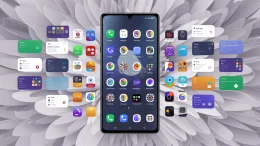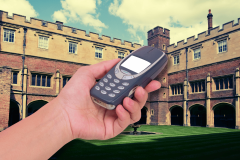So you’ve downloaded and installed the iOS 8 beta, poked around and seen the sights. But now the fun has worn off—your battery runs down too fast and your iPhone keeps crashing. Having a beta operating system on your phone, it turns out, isn’t such a good idea after all. (Don’t say we didn’t warn you.)
That means It’s probably time to get rid of iOS 8 beta and downgrade back to the more stable iOS 7.1. Don’t worry, you can get iOS 8 again once Apple releases a stable release coincident with the launch of the next iPhone later this year.
See also: How To Download And Install iOS 8 Beta
Downgrading is not as hard as you might think. Basically, all you need to do is find the right version of iOS 7.1 for your device and then follow the steps below.
Note: Apple does not condone downgrading from new versions of the operating systems back to old ones. On its developer page (paid login required), the company issues this warning:
Devices updated to iOS 8 beta can not be restored to earlier versions of iOS. Only registered development devices will be able to upgrade to future beta releases and the final iOS software.
Apple says that it can’t be done—but it can be done, and without much effort, either.
Step 1: Identify Your iDevice And Download The iOS 7.1.1 File
You might think that there’s a one-size-fits-all version of iOS 7.1 for every iDevice. Not true. If you have an iPad Air with 4G LTE, it uses a version of iOS 7.1 that’s slightly different from the version on an iPad Air without LTE. Put the wrong version on your device and, at best, it will just flake out unpredictably. (In the worst case, you might have an iBrick on your hands.)
So you have to make sure to get the right version when you downgrade.
First, you’ll need to figure out the model number of your device. The important part is to know what carrier and model you are using. For instance, if you have an iPhone 5S on Verizon or Sprint, you will download the CDMA version of iOS 7.1 and your model number is either A1453 or A1533). You can check model numbers for the iPhone here and the iPad here.
If you need double-check your model number and global carrier, try this Apple support page.
Now it’s time to download the correct version of iOS 7.1. At the end of this post you’ll find direct download links to the various versions of iOS 7.1.1 for particular model numbers and cellular/carrier type . Just find your device and hit the appropriate link.
That’ll automatically download an .ipsw file that contains your version of iOS 7.1.1. Make sure you have the most current version of iTunes installed on your computer.
Step 2: Make Sure You Really Want To Downgrade To iOS 7.1
Ask yourself if you’re really ready to downgrade from the iOS 8 beta back to iOS 7. Downgrading is a destructive process; it will erase all data on your device. And if you backed up your photos, music and files while on iOS 8 beta, you won’t be able to recover using that backup using iOS 7.1.
Also note that Apple’s only signs the latest versions of iOS. For instance, the most current version of iOS (before iOS 8 beta) is iOS 7.1.1. That means you cannot download and install iOS 7.0 or iOS 7.0.6 and so forth. The download links below are for iOS 7.1.1, but Apple may have a new version of iOS 7 (iOS 7.1.2, for example) between now and the public release of iOS 8. If so, you’ll need to download that version of iOS 7.1. (We’ll try to update the links; just beware in case we don’t get to it expeditiously.)
Also remember that this downgrade process will stop working once Apple releases the official version of iOS 8 later this year.
Step 3: Recovery Mode, Cancel Autosync
Many people suggest that you put your iPhone or iPad into “Recovery Mode” before attempting to downgrade from iOS 8 to iOS 7.1. Recovery Mode is an intermediate iOS state typically used when you want to restore the phone from a backup file or to wipe it and activate it as a new phone.
Putting your phone or tablet into Recovery Mode is a breeze:
- Plug the iDevice USB into your computer. Do not plug in your iPhone or iPad yet.
- Turn off your iPhone or iPad by holding the power button until you can slide to power off.
- Press and hold the Home button while connecting the USB cable that’s plugged into your computer into your device. This could power on the iPhone or iPad.
- Continue to hold the Home button until the Apple logo shows up and says “Connect to iTunes.” Release the Home button. You should get a message saying the device is in Recovery Mode.
Some people may say to put the phone into Download Firmware Update mode, but we found this isn’t really necessary, and it can also be a bit tricky. DFU mode is more commonly used if you’re jailbreaking an iOS device.
Once you’re in Recovery Mode, iTunes may open automatically and start syncing your device. Do not let iTunes do this. If it starts syncing, cancel the process.
Now, hold the Option key (the Shift key for Windows computers) and click “Restore” in iTunes. This will bring up a file finder window. Pick the .ipsw file you downloaded in step 1 and install it. If you picked the right version of iOS 7.1—the most current version suited for your iPhone or iPad model), you should easily make it through the set up wizard and get back to normal.
This process will wipe out all data on your device and restore it to factory settings.
Errors To Watch For
Remember, if you backed up your phone while using the iOS 8 beta and saved it on iTunes or iCloud, you aren’t going to be able to restore from that backup on iOS 7.1.
If you get an iTunes error or the setup won’t work, there’s a good chance you downloaded the wrong version of iOS 7.1, or aren’t using the most current version (assuming Apple has issued updates subsequent to iOS 7.1.1).
Below are the direct download links for iOS 7.1.1. Remember, if there’s a newer version of iOS 7.1, you’ll need to use that instead.
iPad
- iPad Air (Model A1474) (Wi-Fi only)
- iPad Air (Model A1475) (Wi-FI + Cellular)
- iPad mini (Model A1489) (Retina Display Wi-Fi only)
- iPad mini (Model A1490) (Retina Display Wi-Fi + Cellular)
- iPad (4th generation Model A1458) (Wi-Fi only)
- iPad (4th generation Model A1459) (Wi-Fi + Cellular)
- iPad (4th generation Model A1460) (Wi-Fi + Cellular MM)
- iPad mini (Model A1432) (Wi-Fi only)
- iPad mini (Model A1454) (Wi-Fi + Cellular)
- iPad mini (Model A1455) (Wi-Fi + Cellular MM)
- iPad Wi-Fi 3rd generation (Model A1416) (Wi-Fi only)
- iPad 3rd generation (Model A1430) (Wi-Fi + Cellular for AT&T)
- iPad 3rd generation (Model A1430) (Wi-Fi + Cellular for Verizon)
- iPad 2 Wi-Fi (Model A1395)
- iPad 2 Wi-Fi (Rev A)
- iPad 2 Wi-Fi + 3G (Model A1396) (GSM)
- iPad 2 Wi-Fi + 3G (Model A1397) (CDMA)
iPhone
- iPhone 5s (Model A1453, A1533) (CDMA)
- iPhone 5s (Model A1457, A1518, A1528, A1530) (GSM including China)
- iPhone 5c (Model A1456, A1532) (CDMA)
- iPhone 5c (Model A1507, A1516, A1526, A1529) (GSM including China)
- iPhone 5 (Model A1428) (GSM)
- iPhone 5 (Model A1429) (GSM and CDMA)
- iPhone 4s (Model A1387) (GSM and CDMA)
- iPhone 4 (Model A1332) (GSM)
- iPhone 4 (GSM Rev A)
- iPhone 4 (Model A1349) (CDMA)
- iPod touch (5th generation)

















